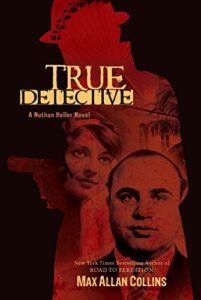by Max Allan Collins
 Author Max Collins ingeniously inserts his fictional protagonist, ex-cop turned P.I. Nathan Heller, into historical events in gang-ruled Chicago in the 1930s.
Author Max Collins ingeniously inserts his fictional protagonist, ex-cop turned P.I. Nathan Heller, into historical events in gang-ruled Chicago in the 1930s.
Collins brings the streets of Chicago and the poverty of the Depression to life. Prohibition Agent Eliot Ness is a friend of Nate’s. Actor George Raft does him a few favors.
TRUE DETECTIVE won a Shamus Award for best novel from the Private Eye Writers of America.
Collins continued blending fact and fiction by involving Nate in a variety of other historical events. The books that follow, in order of publication, are:
- TRUE CRIME (1984). Heller finds himself trying to foil a plan by Ma Barker’s boys to kidnap FBI Director J. Edgar Hoover after John Dillinger supposedly dies.
- THE MILLION DOLLAR WOUND (1986). After returning home as decorated, damaged, and dangerous hero from fighting in Guadalcanal, Heller finds himself in another war, a gang coup to topple Frank Nitti as he tries to strong-arm the Hollywood unions.
- NEON MIRAGE (1988). Heller clears Bugsy Siegel of murder and then becomes his friend. After Bugsy invents modern Vegas and is gunned down in 1947, Heller becomes his avenger.
- STOLEN AWAY (1991). Heller is brought in when jailed Al Capone claims he can help find the Lindbergh baby, kidnapped in 1932.
- CARNAL HOURS (1994). Heller races to the Bahamas to clear a wealthy man’s playboy son-in-law of charges of his murder in a fire. Heller finds himself investigating in the midst of stray bullets, Nazi spies and carnal distractions.
- BLOOD AND THUNDER (1995). Heller finds himself in “the dangerous swamp of Louisiana’s mob-infested political machine when former govern-turned-presidential candidate Huey Long is assassinated” in 1935.
- DAMNED IN PARADISE (1996). Heller takes a leave from the Chicago police department to go to Hawaii to help family friend attorney Clarence Darrow investigate the rape and murder of a bride in the early 1930s.
- FLYING BLIND (1998). Hired to guard pioneering pilot Amelia Earhart against death threats, Heller finds himself mounting a one-man-search for her whereabouts when she goes missing in the South Pacific in 1937.
- MAJIC MAN (1999). Heller goes to Washington, D.C., in the late 1940s to protect Secretary of Defense James Forrestal from a murder threat. But is the secretary’s real enemy his own mental illness? Heller investigations lead him to Roswell, New Mexico, and surprising UFO revelations.
- ANGEL IN BLACK (2001). Honeymooning in L.A., Heller finds himself a suspect in the LA Police Department’s investigation of the 1947 Black Dahlia murder. He has to rely on his old friend Eliot Ness to solve the crime before it’s too late.
- CHICAGO CONFIDENTIAL (2002). It’s the early 1950s, Heller is keeping his head down, caught between the Kefauver Organized Crime investigation and his reluctant ties to the Mafia. Then an honest cop and a lovely drug addict are murdered and he decides it’s time for some rough justice.
- BYE BYE, BABY (2011). It’s 1962 and 20th Century Fox is threatening to fire Marilyn Monroe. She hires Heller to tap her phone to have a record of the studio’s calls in case they take her to court. When Heller listens in he discovers that there’s much more interest in Marilyn than just the studio’s. Not long after Heller signs on, Marilyn checks out, dead of an overdose.
- TARGET LANCER (2012). Heller’s involvement with the Kennedys, the Mob and the CIA puts him in a prime position to spot an assassination conspiracy in the making — that of President John F. Kennedy.
- ASK NOT (2013). It’s Chicago in September 1964. The times, they are a-changing. There’s a wave of suicides, accidental deaths and murders among witnesses to President John F. Kennedy’s assassination. When Heller and his son are nearly run down on a city street, he begins to wonder if maybe he is a loose end. Allied with celebrity columnist Flo Kilgore in Texas, he begins to investigate the growing wave of violence that seems to emanate from notorious Mac Wallace, rumored to be LBJ’s personal hatchet man.
- BETTER DEAD (2016). In the early 1950s, Heller finds himself reluctantly doing legwork for Sen. Joe McCarthy in his campaign to rid America of Communists. He makes friends with young staffer Robert Kennedy. He’s approached by mystery writer Dashiell Hammett representing a group of Hollywood and literary leftists who are attempting to save Julius and Ethel Rosenberg from prosecution as spies for atomic bomb secrets. Heller has a delicate balancing act as he works both sides.
- DO NO HARM (2020). It’s 1954 and the headlines are full of the young doctor Sam Sheppard case, accused of brutally murdering his wife. The doctor claims he was startled from sleep and discovered her dead. The evidence suggests a disturbed husband weary of married life and willing to do anything to be free. Heller’s old friend Eliot Ness calls in a favor and Heller begins to investigate.
About the Author: Max Allan Collins (1948 – )
Max Allan Collins is an American mystery writer and graphic novelist. He wrote the Dick Tracy newspaper comic strip after its creator Chester Gould stopped writing and created a series called ROAD TO PERDITION, which became the basis for a 2002 movie of the same name.
He’s written historic novels, screenplays, trading cards, short stories and movie novelizations. A fan of mystery writer Mickey Spillane from childhood, he became friends with the author. They collaborated on a comic book series in the 1990s called MIKE DANGER. When Spillane died in 2006, Collins was authorized to finished several of Spillane’s uncompleted works, including DEAD STREET, THE GOLIATH BONE and THE BIG BANG.
His work has been recognized with a 1982 Inkpot Award, awarded annually by Comic-Con International, and the 1984 and 1992 Shamus Awards, given by the Private Eye Writers of America.
He co-founded the International Association of Media Tie-in Writers with lee Goldberg.
Collins studied at the Iowa Writers’ Workshop at the University of Iowa.
Collins and his wife Barbara have a son, Nathan. He writes for and performs with a rock band, Crusin’. He lives in Muscatine, IA.



